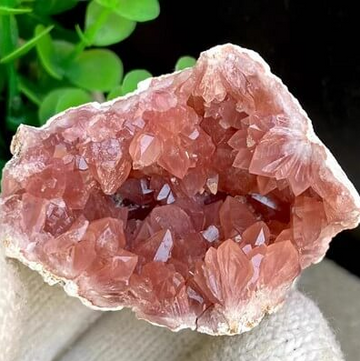Crystals, those mesmerizing formations that adorn our jewelry and capture our imaginations, are born from dramatic geological processes deep within the Earth. At LYRIAH Jewelry, we appreciate not only the beauty of these natural wonders but also the fascinating stories of their origin. Today, we’re diving into the geological processes that give rise to quartz crystals, one of the most abundant and beloved minerals on Earth.
A Crystal’s Birth Story: Three Primary Origins
Quartz crystals, characterized by their unique silicon dioxide (SiO2) structure, are primarily formed through three key geological processes: magmatic activity, hydrothermal activity, and metamorphism.
1. Magmatic Origins: Crystallization from Molten Rock
Deep within the Earth, magma—a superheated, pressurized, molten substance—teems with minerals and gases. As magma slowly cools underground, the elements within begin to crystallize due to changes in temperature and pressure. In specific conditions, silicon and oxygen atoms arrange themselves in a precise lattice structure, forming quartz crystals.
- Where to Find Them: These magmatically formed crystals are typically discovered within igneous rocks like granite. Around large granite intrusions, you can often find quartz veins. These crystals grow gradually within fractures and cavities as the magma intrudes, cools, and solidifies.
2. Hydrothermal Origins: Sculpted by Hot Water Solutions
Hydrothermal activity involves underground hot water solutions circulating through pores and fissures in rocks. These solutions are rich in dissolved minerals, including silicon, aluminum, and iron. When the hot water interacts with surrounding rocks, it dissolves certain elements and, under the right conditions, precipitates them, forming crystals.
- Where to Find Them: When silicon and oxygen reach a critical concentration and suitable physicochemical conditions prevail, they crystallize into quartz. This type of quartz is commonly found in hydrothermal deposits, such as quartz vein-type deposits. In these deposits, quartz often coexists with other metallic minerals like gold, silver, and copper.
3. Metamorphic Origins: Transformation Under Pressure
During crustal movements, rocks are subjected to high temperatures, pressures, and chemically active fluids, leading to metamorphism. In this process, the mineral composition and structure of existing rocks change.
- Where to Find Them: Rocks containing silica undergo recrystallization and enrichment during metamorphism, sometimes forming quartz crystals. These crystals can be found in metamorphic rocks like gneiss and quartzite. Their crystal morphology and characteristics are often influenced by the degree of metamorphism and the composition of the original rock.
A Global Perspective: The World’s Quartz Hotspots
Quartz crystals are found worldwide, but certain regions are particularly renowned for their abundance and quality:
- Brazil: The world’s largest producer of quartz, with the state of Minas Gerais being especially famous for its high-quality crystals.
- United States: Significant quartz deposits are found in various states, including Arkansas and California.
- Russia: Known for its unique quartz formations and mineral specimens.
- Madagascar: A source of diverse and colorful quartz varieties.
- China: Boasts significant quartz reserves, particularly in Jiangsu’s Donghai County, known as the “Crystal Capital of China” for its rich deposits and thriving crystal processing industry.
The LYRIAH Commitment: Sourcing Earth’s Treasures
At LYRIAH Jewelry, we are fascinated by the geological processes that create the beautiful quartz crystals we use in our designs. We source our crystals responsibly, ensuring that they are ethically mined and handled with care. Each piece tells a story of Earth’s power and artistry.
Explore our collection and discover the magic of quartz crystals, a testament to the wonders of our planet!







